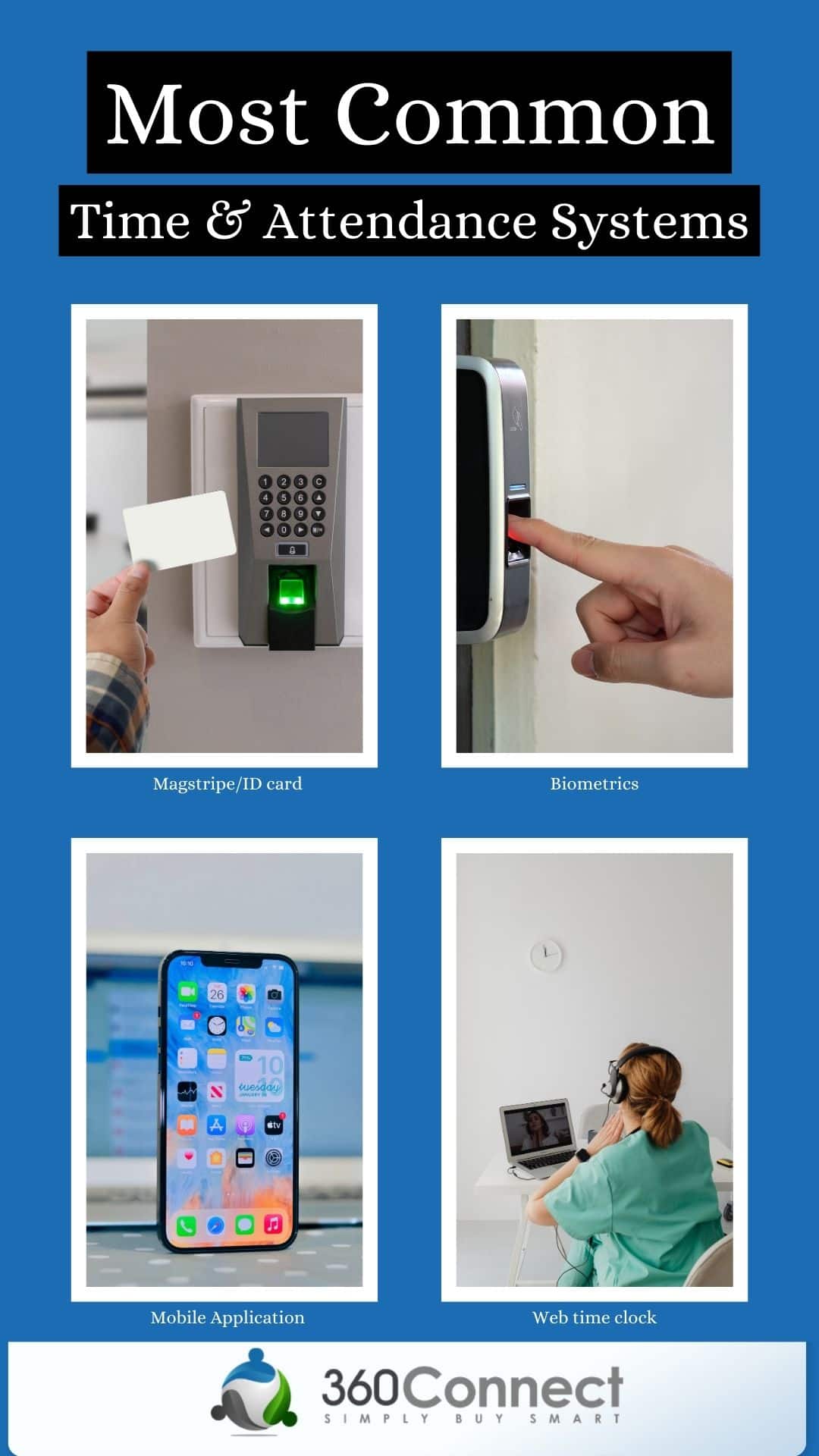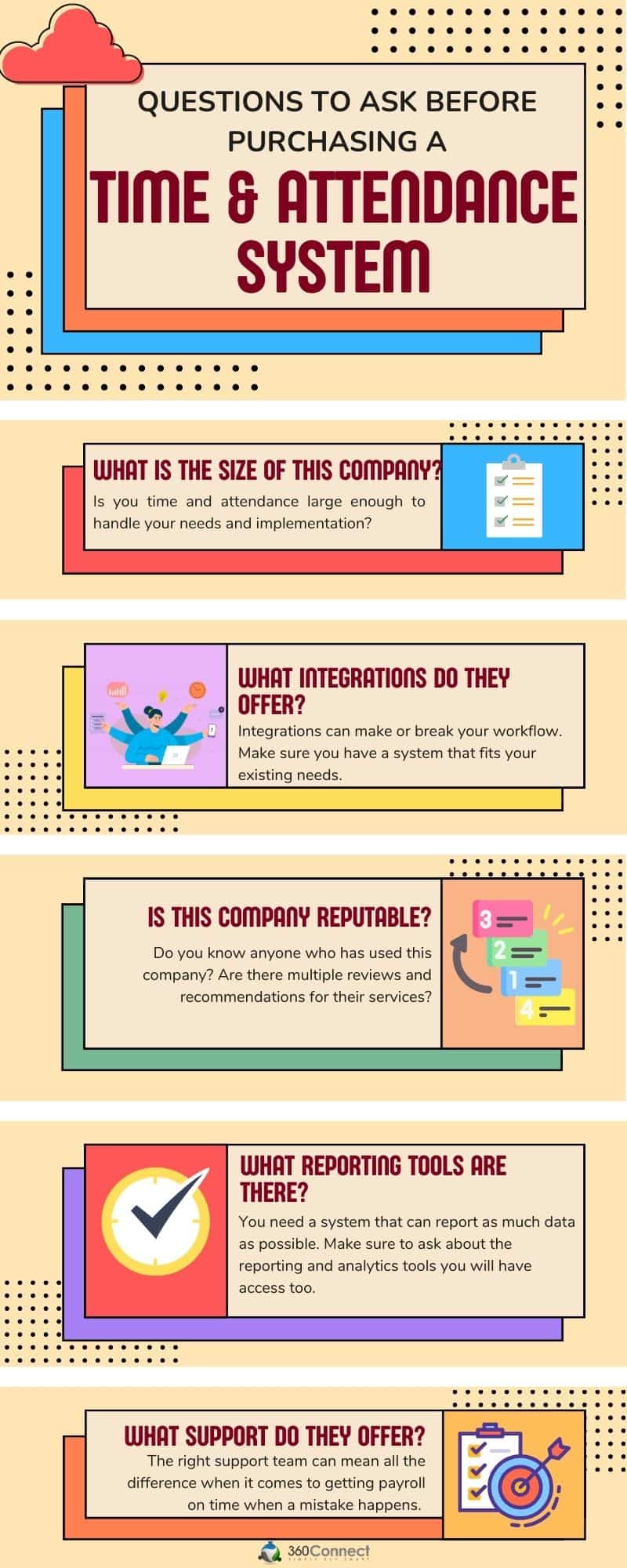Buying Time and Attendance Software
GET FREE QUOTESA Time And Attendance System Buyer's Guide
Time and attendance systems are software tools businesses use to manage their employees’ hours and attendance. They can provide accurate records of when employees clock in and out of work, even when employees work remotely.
These systems can provide detailed reports on employee work patterns, payroll, vacation days taken, and more information. Most importantly, time and attendance software give businesses the tools to make sure employees stay compliant with business policy and government policies.
What are Time and Attendance Systems
In its simplest form, time and attendance systems are software tools to record the hours worked by an employee. Recording hours worked can be done by a couple of different methods:
- Punch card systems
- A punch card system marks on a piece of paper the hours clocked in and out. These systems also need a physical time clock.
- A biometric time and attendance system is a technology that uses unique personal traits (fingerprint, retina, facial, etc.) to verify an individual’s identity and record hours worked. This provides an additional level of security.
- Barcode systems
- The method utilizes barcodes scanned from identification cards or mobile devices to record hours.
- Magnetic stripe systems
- These system work by swiping a magnetic stripe card through a card reader. The card can be slid into a wallet or attached to a lantern.
- Smart card systems
- Much like magnetic stripe cards, these systems use a card with an embedded chip and a card reader to record hours.
- Mobile time and attendance systems
- A mobile app is downloaded on the employee’s phone where they can clock in even when in remote locations using GPS location.
- Web-based time and attendance systems
- A web-based time and attendance system is a method of tracking employees’ work hours through an internet browser, allowing for real-time monitoring and management from anywhere with an internet connection.

This data is then logged into the software to be easily viewable and collected for many uses. While in your most barebones form, the software will just collect hours worked. Nowadays, most time and attendance systems are capable of advanced features like payroll integration and remote reporting capabilities.
Are Time and Attendance Systems Necessary?
Time and attendance systems provide your company with the easiest and fastest solution to track employee time. You are able to simplify payroll, manage time off, and review hours worked with a couple of taps of a button. Employees can also submit time off and input overtime right from their phone or their computer. All of this can be traced when employees clock in and out of work. Time and attendance software can also help you create a solid time policy.

Common Time and Attendance System Features:
- Employee Time Tracking: The software can record and track the exact time an employee starts and ends work, as well as breaks and overtime.
- Scheduling: The ability to create, publish, and manage schedules for employees with a couple of clicks. Some programs allow for the automation of this process as well if your schedule is that predictable.
- Time Off Requests: The ability for employees to request time off, with automatic approval or denial within the software. This can be done on mobile or the web with a login.
- Leave Management: The ability to manage and track leave entitlements, such as vacation time, sick leave, and personal days.
- Payroll Integration: Most time and attendance software can integrate with payroll systems so one person can run payroll in minutes not hours.
- Mobile Application: Employees and managers can manage their time all in one application.
- Reporting: You can have the software generate reports about hours worked, average leave taken, and highlight unresolved HR needs.
- Time Clock Integration: The ability to integrate with physical time clocks, such as biometric devices or swipe cards.
- Compliance: The ability to ensure compliance with relevant labor laws and regulations, such as minimum wage requirements and overtime pay within your state.
- Geofencing: The ability to track an employee’s location and confirm that they are at the worksite through GPS technology (usually by phone)
- Real-Time Monitoring: The ability to view and monitor employee attendance in real-time.
- Automated Notifications: Employees and managers can receive automated notifications for important events/reminders, such as schedule changes or time-off requests.
- Access Control: The ability to control access to company premises through the use of biometric or card-based systems.
- Overtimes and Shift Differentials: The ability to automatically calculate and pay employees for overtime and shift differentials.
- Accruals Management: The ability to track and manage accruals, such as vacation or sick leave accruals.
- Multi-Language Support: The ability to support multiple languages to accommodate a diverse workforce.
- Customizable Workflows: The ability to customize workflows, such as time-off request approval processes, to meet the specific needs of an organization.
- Data Security: The ability to secure employee data through the use of encryption and secure access controls.
5 Benefits of a Time and Attendance System You Need to Know!
Improved Accuracy and Efficiency
Time and attendance software can improve your ability to track employees’ hours. Even working remotely, you can still track when employees are clocking into work with GPS location tools. More importantly, most software can automatically flag when an employee has fewer hours than they should or works overtime.
Real-Time Management
Would you like to see which employees are working in different locations? With time and attendance software you can! Track who’s working and where in real-time. This can simplify your workload and increase productivity with managers.
Streamlined Payroll Processes
The use of time and attendance systems automates the process of tracking employees’ working hours and simplifies payroll duties by eliminating the need for manual timekeeping. The system records data such as arrival/departure times, break times, and integrates with payroll systems to provide accurate data for payroll processing. Payroll processing is thus simplified and time-saving.
Compliance with Labor Laws
There are both federal and state labor laws that companies must follow. Time and attendance software can have those regulations implemented into the software. Some software can automatically flag when employees are going to violate those regulations. Not only are your workers protected but so is your company.
Reduced Time and Cost for Manual Data Entry
You don’t manually type in reports or manually review each shift worked. The time and attendance software can easily input this data for you and make it viewable within the spreadsheet. It can also automatically identify where problems may arise and miscalculated hours.
FAQ about Time and Attendance Systems:
A time and attendance system is a software or hardware solution used to track and manage the hours of employees. It records when employees arrive and leave the workplace and can help businesses simplify administrative tasks.
Lorem ipsum dolor sit amet, consectetur adipiscing elit, sed do eiusmod tempor incididunt ut labore et dolore magna aliqua. Ut enim ad minim veniam, quis nostrud exercitation ullamco laboris nisi ut aliquip ex ea commodo consequat.
Q: What is a time and attendance system?
A: A time and attendance system is a software or har
Q: Why do companies use time and attendance systems?
A: Time and attendance systems help companies tackle tasks such as:
- Accurately track employee working hours
- Track remote hours worked
- Ensure compliance with labor laws and regulations
- Simplify payroll processing
- Reduce errors and improve administrative accuracy
To monitor attendance and punctuality
Q: How does a time and attendance system work?
A: Time and attendance systems can work in various ways, some of the most common include:
Punch clock systems, where employees physically clock in and out using a card or biometric reader
Mobile time tracking, where employees use a smartphone or tablet to clock in and out
Web-based systems, where employees access the system through a web browser to record their working hours
[view section about types of time and attendance systems above for more options]
Q: What are the different types of time and attendance systems?
A: There are several types of time and attendance systems, including:
- Biometric systems, which use fingerprint or facial recognition to identify employees
- Card-based systems, which use swipe cards or proximity cards to track attendance
- Web-based systems, which are accessible through a web browser
- Mobile systems, which use smartphones or tablets to record working hours
[view section about types of time and attendance systems above for more options]
Q: What are the benefits of using a time and attendance system?
A: Some of the benefits of using a time and attendance system include:
- Improved accuracy and reduced manual errors
- Easier and more efficient payroll processing
- Better compliance with labor laws and regulations
- Increased visibility into attendance patterns and employee productivity
- Reduced labor costs through more efficient use of working hours
Q: Are time and attendance systems easy to use?
A: Most systems are designed to be very user-friendly. The training needed for a new system will depend on the size of your complex and the number of features you will need to learn.
